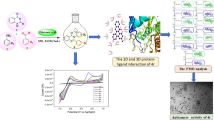Abstract
A new Ru(II) complex [Ru(dmp)2(NMIP)](ClO4)2 (dmp = 2,9-dimethyl-1,10-phenanthroline, NMIP = 2’-(2″-nitro-3″,4″-methylenedioxyphenyl)imidazo[4′,5′-f][1,10]-phenanthroline) was synthesized and characterized by elemental analysis, ESI–MS and 1H NMR. The cytotoxic activity of the complex against MG-63, U2OS, HOS, and MC3T3-e1 cell lines was investigated by MTT method. The complex shows moderate cytotoxicity toward HOS (IC50 = 35.6 ± 2.6 µM) and MC3T3-e1 (IC50 = 41.6 ± 2.8 µM) cell lines. The morphological studies show that the complex can induce apoptosis in HOS cells and cause an increase of reactive oxygen species levels and a decrease in the mitochondrial membrane potential. The cell cycle distribution demonstrates that the complex inhibits the cell growth at S phase. Additionally, the antitumor activity in vivo reveals that the complex can induce a decrease in tumor weight.









Similar content being viewed by others
References
Antonarakis ES, Emadi A (2010) Ruthenium-based chemotherapeutics: are they ready for prime time? Cancer Chemother Pharmacol 66:1–9
Bergamo A, Gagliardi R, Scarcia V, Furlani A, Alessio E, Mestroni G, Sava G (1999) In vitro cell cycle arrest, in vivo action on solid metastasizing tumors, and host toxicity of the antimetastatic drug NAMI-A and Cisplatin. J Pharmacol Exp Ther 289:559–564
Cao RH, Chen Q, Hou XR, Chen HS, Guan HJ, Ma Y, Peng WL, Xu AL (2004) Synthesis, acute toxicities and antitumor effects of novel 9-substitute β-carboline derivatives. Bioorg Med Chem 12:4613–4623
Chen Y, Qin MY, Wang L, Chao H, Ji LN, Xu AL (2013) A ruthenium(II) β-carboline complex induced p53-mediated apoptosis in cancer cells. Biochimie 95:2050–2059
Collin JP, Sauvage JP (1986) Synthesis and study of mononuclear ruthenium(II) complexes of sterically hindering diimine chelates. Implications for the catalytic oxidation of water to molecular oxygen. Inorg Chem 25:135–141
Devi CS, Kumar DA, Singh SS, Gabra N, Deepika N, Kumar YP, Satyanarayana S (2013) Synthesis, interaction with DNA, cytotoxicity, cell cycle arrest and apoptotic inducing properties of ruthenium(II) molecular “light switch” complexes. Eur J Med Chem 64:410–421
Galanski M (2006) Recent developments in the weld of anticancer platinum complexes. Recent Pat Anticancer Drug Discov 1:285–295
Gorle AK, Ammit AJ, Wallace L, Keene FR, Collins JG (2014) Multinuclear ruthenium(II) complexes as anticancer agents. New J Chem 38:4049–4059
Howerton BS, Heidary DK, Glazer EC (2012) Strained ruthenium complexes are potent light-activated anticancer agents. J Am Chem Soc 134:8324–8327
Jiang GB, Yao JH, Wang J, Li W, Han BJ, Lin GJ, Xie YY, Huang HL, Liu YJ (2014) The induction of apoptosis in BEL-7402 cells through the ROS-mediated mitochondrial pathway by a ruthenium(II) polypyridyl complex. New J Chem 38(6):2554–2563
Juan ME, Wenzel U, Daniel H, Planas JM (2008) Resveratrol induces apoptosis through ROS-dependent mitochondria pathway in HT-29 human colorectal carcinoma cells. J Agric Food Chem 56:4813–4818
Label CP, Ischiropoulos H, Bondy SC (1992) Evaluation of the probe 2′,7′-dichlorofluorescin as an indicator of reactive oxygen species formation and oxidative stress. Chem Res Toxicol 5:227–231
Lai SH, Jiang GB, Yao JH, Li W, Han BJ, Zhang C, Zeng CC, Liu YJ (2015) Cytotoxic activity, DNA damage, cellular uptake, apoptosis and western blot analysis of ruthenium(II) polypyridyl complex against human lung decarcinoma A549 cell. J Inorg Biochem 152:1–9
Li W, Han BJ, Yao JH, Jiang GB, Liu YJ (2015) Cytotoxicity in vitro, cell migration and apoptotic mechanism studies induced by ruthenium(II) complexes. RSC Adv 5:24534–24543
Lo KK, Lee TK, Lau JS, Poon WL, Cheng SH (2008) Synthesis, interaction with DNA, cytotoxicity, cell cycle arrest and apoptotic inducing properties of ruthenium(II) molecular “light switch” complexes. Inorg Chem 47:200–208
Luo ZD, Yu LL, Yang F, Zhao ZN, Yu B, Lai HQ, WongKH Ngai SM, Zheng WJ, Chen TF (2014) Ruthenium polypyridyl complexes as inducer of ROS-mediated apoptosis in cancer cells by targeting thioredoxin reductase. Metallomics 6:1480–1490
Peña B, David A, Pavani C, Baptista MS, Pellois JP, Turro C, Dunbar KM (2014) Cytotoxicity studies of cyclometallated ruthenium(ii) compounds: new applications for ruthenium dyes. Organometallics 33:1100–1103
Rajendiran V, Palaniandavar M, Periasamy VS, Akbarsha MA (2012) New [Ru(5,6-dmp/3,4,7,8-tmp)2(diimine)]2 complexes: non-covalent DNA and protein binding, anticancer activity and fluorescent probes for nuclear and protein components. J Inorg Biochem 116:151–162
Sava G, Bergamo A, Zorzet S, Gava B, Casarsa C, Cocchietto M, Furlani A, Scarcia V, Serli B, Iengo B, Alessio E, Mestroni G (2002) Influence of chemical stability on the activity of the antimetastasis ruthenium compound NAMI-A. Eur J Cancer 38:427–435
Tan LF, Chao H, Liu YJ, Li H, Sun B, Ji LN (2005) DNA-binding and photocleavage studies of [Ru(phen)2(NMIP)]2+. Inorg Chim Acta 358:2191–2198
Tan LF, Shen JL, Liu J, Zeng LL, Jin LH, Weng C (2012) Spectral characteristics, DNA-binding and cytotoxicity of two functional Ru(II) mixed-ligand complexes. Dalton Trans 41:4575–4587
Yang XX, Chen LM, Liu YN, Yang YG, Chen TF, Zheng WJ, Liu J, He QY (2012) Ruthenium methylimidazole complexes induced apoptosis in lung cancer A549 cells through intrinsic mitochondrial pathway. Biochimie 94:345–353
Ye J, Wang S, Leonard SS, Sun Y, Butterworth L, Antonini J, Ding M, Rojanasakul Y, Vallyathan V, Castronova V, Shi X (1999) Role of reactive oxygen species and p53 in chromium(VI)-induced apoptosis. J Biol Chem 274:34974–34980
Acknowledgments
This work was supported by the National Nature Science Foundation of China (Nos. 81272941, 81201864), the Health and Family Planning Commission of Guangzhou Municipality (20141A010001), and the Guangdong Provincial Department of Science and Technology (2014A020212009).
Author information
Authors and Affiliations
Corresponding author
Additional information
Jian-Wei Zhu and Si-Hong Liu contributed equally to this work.
Rights and permissions
About this article
Cite this article
Zhu, JW., Liu, SH., Zhang, GQ. et al. Anticancer Activity Studies of Ruthenium(II) Complex Toward Human Osteosarcoma HOS Cells. J Membrane Biol 249, 483–492 (2016). https://doi.org/10.1007/s00232-016-9889-y
Received:
Accepted:
Published:
Issue Date:
DOI: https://doi.org/10.1007/s00232-016-9889-y




